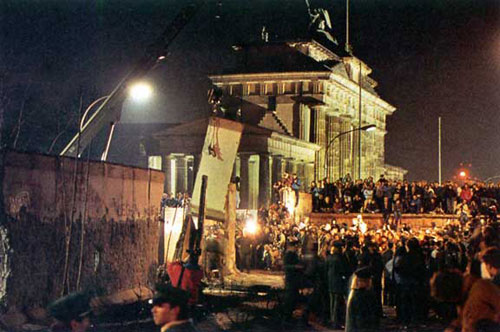On the night of August 12 1961, in one of the most secretive missions carried out in history, more than four thousand Soviet troops converted what had been an imaginary dividing line through Berlin into a very real line. The next morning incredulous Berliners, on both sides of the East-West divide, woke up face to face with the wall that was to keep them divided, both politically and physically for the next four decades.

During those early days the wall was just a fence, heavily guarded by well-armed soldiers. It was not unknown for these soldiers to escape to the West side themselves. The first one on record was 19 year-old Hans Conrad Schumann who threw away his gun and ran to the other side when his comrades were distracted. He became famous for being the first deserter of the Berlin Wall.
The wall was built quickly and efficiently. It soon became an impregnable border, dividing Berlin in two, splitting apart families, lovers and friends. Several gates were fitted to allow entry to authorized military personnel and international ambassadors. Each of these entry points was named after a letter: A (Alpha), B (Bravo) or C (Charlie). In Friedrichstraße was the letter C: Checkpoint Charlie. The name of this gateway was all over the media in October 1961, when Soviet tanks faced off against American tanks, both sides with their fingers on the trigger and about to start World War 3.
Although that particular moment of crisis was resolved, there were many more tragedies which occurred around the wall. The documentation centre in Potsdam states that a total of 120 people died. Other sources cite twice that amount. Everyone has their own horror story, their own tragic adventure in search of freedom. Undoubtedly the most well-known incident was that which involved the young construction worker, Peter Fechter, an 18-year-old idealist who was willing to risk his life in a bid to reach the west one hot summer’s day on August 17, 1962. Two soldiers (later tried when they were old men) shot the mason as he was about to jump. The bullets hit Fechter’s pelvis, and he fell on the West side where he bled to death, receiving no help from anyone. A minimalist monument erected in Zimmerstraße reminds visitors and passersby of this tragic event.
Decades later, the witnesses to that tragic scene confess to having been possessed and paralysed by fear. Today there are just a few pieces of the wall remaining (like the East Side Gallery) and Checkpoint Charlie has been rebuilt next to a museum that brings to life this intense part of Berlin’s history. It is definitely worth a visit.
 Candela Vizcaíno
Candela Vizcaíno
apartments in Berlin situated in this zone are haunted by the stories of hundreds of Berliners who searched for freedom and light in dark times.

 English
English Translated by: Ben Palmer
Translated by: Ben Palmer